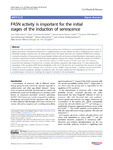FASN activity is important for the initial stages of the induction of senescence

View/
Use this link to cite
http://hdl.handle.net/2183/36820
Except where otherwise noted, this item's license is described as Creative Commons Attribution 4.0 International License (CC-BY 4.0)
Collections
- Investigación (FCS) [1293]
Metadata
Show full item recordTitle
FASN activity is important for the initial stages of the induction of senescenceAuthor(s)
Date
2019-04-08Citation
Fafián-Labora J, Carpintero-Fernández P, Jordan SJD, Shikh-Bahaei T, Abdullah SM, Mahenthiran M, Rodríguez-Navarro JA, Niklison-Chirou MV, O'Loghlen A. FASN activity is important for the initial stages of the induction of senescence. Cell Death Dis. 2019 Apr 8;10(4):318.
Abstract
[Abstract] Senescent cells accumulate in several tissues during ageing and contribute to several pathological processes such as ageing and cancer. Senescence induction is a complex process not well defined yet and is characterized by a series of molecular changes acquired after an initial growth arrest. We found that fatty acid synthase (FASN) levels increase during the induction of senescence in mouse hepatic stellate cells and human primary fibroblasts. Importantly, we also observed a significant increase in FASN levels during ageing in mouse liver tissues. To probe the central role of FASN in senescence induction, we used a small-molecule inhibitor of FASN activity, C75. We found that C75 treatment prevented the induction of senescence in mouse and human senescent cells. Importantly, C75 also reduced the expression of the signature SASP factors interleukin 1α (IL-1α), IL-1β and IL-6, and suppressed the secretion of small extracellular vesicles. These findings were confirmed using a shRNA targeting FASN. In addition, we find that FASN inhibition induces metabolic changes in senescent cells. Our work underscores the importance of C75 as a pharmacological inhibitor for reducing the impact of senescent cell accumulation.
Keywords
Cellular senescence
Fatty acid synthase Type I
Fibroblast
Hepatic stellate cells
Mitochondria
Fatty acid synthase Type I
Fibroblast
Hepatic stellate cells
Mitochondria
Editor version
Rights
Creative Commons Attribution 4.0 International License (CC-BY 4.0)
ISSN
2041-4889






